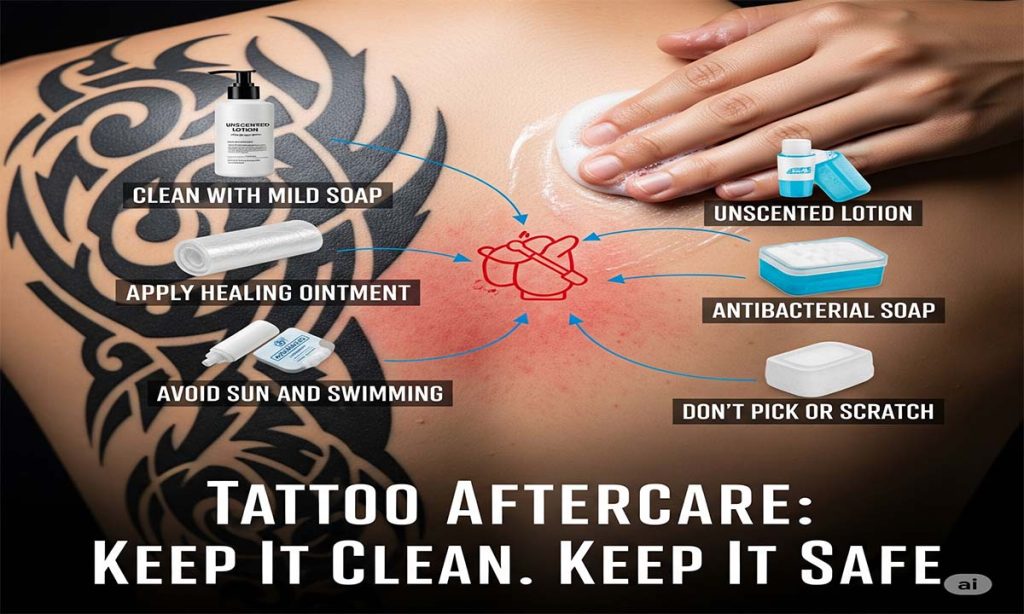A professional artist tattooing a fresh design on a person’s arm. Getting a new tattoo is exciting, but it comes with the responsibility of proper tattoo aftercare. Tattoo aftercare (in Danish “tattoo efterpleje”) refers to the steps you take immediately after getting inked to promote healing and prevent complications. According to the Pew Research Center, about one-third of U.S. adults have at least one tattoo – so knowing how to provide good tattoo aftercare is important for a large number of people. Proper aftercare ensures your tattoo heals correctly, stays vibrant, and avoids infection or scarring. In this comprehensive guide, we’ll cover all the key steps and tips – from first-hour care to long-term maintenance – so you’ll have clear tattoo care instructions for every stage of healing.

Table of Contents
Why Proper Tattoo Aftercare Matters
A new tattoo is essentially an open wound: the needles have pierced your skin thousands of times, depositing ink into your dermis. This means without proper care, it’s easy for bacteria, dirt, and irritants to infect the area. The Mayo Clinic warns that tattooing breaks the skin, leading to risks like skin infections or allergic reactions if care isn’t taken. Indeed, one of the primary goals of tattoo aftercare is to minimize infection and scarring. Health experts note that practices such as using a dressing, cleaning the tattoo, moisturizing, and avoiding sun exposure can greatly reduce complications. In fact, they state:
“Using a dressing over it for a few days, washing the area a couple of times daily, moisturizing several times, and avoiding sun exposure are some ways to care for your tattoo. Proper aftercare can reduce scarring and infections.”
Good aftercare promotes healthy skin regeneration. By keeping the area clean and slightly moist, you help the skin heal smoothly, and by keeping it covered or protected, you prevent dirt and germs from entering. Conversely, neglecting aftercare can lead to faded ink, patchy color, raised scabs (called keloids), or even more serious skin infections. By following reliable tattoo care instructions, you ensure that your new tattoo heals as intended and remains a source of pride for years to come Learn tattoo aftercare tips for a new tattoo – from cleaning and moisturizing to avoiding infection. Expert instructions on how to care for your tattoo.
Initial Aftercare (Days 1–3)
Immediately after your tattoo session, the artist will cover the fresh ink with a bandage or wrap – sometimes a “second skin” adhesive like Saniderm or Tegaderm. Follow your artist’s advice on how long to keep this covering on, but generally it’s removed within a few hours or at most a day. When you get home:
- Wash your hands first. Always start by thoroughly cleaning your hands with soap and water before touching your new tattoo. Think of it as a fresh wound tattoo aftercare
- Remove the bandage and clean gently. Within 1–2 hours (or as directed by your artist), carefully peel off the protective wrap or bandage. Use a gentle, fragrance-free antibacterial soap and lukewarm water to lightly cleanse the tattoo from any blood, plasma, or excess ink. Do not use washcloths, rough sponges, or scrubbing; just use clean hands. Rinse thoroughly and pat the area dry with a clean paper towel or let it air dry. It’s important not to rub the tattoo as this can irritate the skin tattoo aftercare
- Apply a thin layer of ointment or moisturizer. Once the skin is clean and dry (wait a few minutes), apply the aftercare product your artist recommends. For the first few days, this is often a thin film of a tattoo-specific healing ointment or an unscented lotion. Use only clean hands and avoid double-dipping into the ointment pot. Apply just enough to gently cover the tattoo – you want it moist, not smothered in ointment. Too much greasiness can suffocate the skin. (Popular options include a tattoo balm, or even Aquaphor initially – see “Should I Use Aquaphor?” below.)
- Repeat cleaning 1–2 times daily. For the first 3–4 days, wash your tattoo about once or twice each day, especially before reapplying ointment. If the bandage was removed on day 1, continue this routine: gently cleanse and pat dry, then moisturize. If your tattoo was kept wrapped (with a special medical adhesive bandage like Saniderm), follow the bandage manufacturer’s instructions – often the first wrap comes off after 1 day, and you may apply a second piece to protect it for up to 4 days.
During these first days, you will likely notice some fluid and plasma oozing from the tattoo. This is normal (it may include a little excess ink). Your skin might be red, swollen, or warm to the touch – all signs the body is healing. Keep the area clean, and try to sleep in a clean spot without letting fresh ink press against sheets. Overall, the focus is: keep it clean, dry (but moisturized), and protected tattoo aftercare
Mid-Phase Aftercare (Days 4–14)
Around days 4–7, your tattoo will usually start to peel and scab lightly – much like a sunburn peel. This is a healthy part of the process. Follow these guidelines in this stage:
- Peeling and scabbing: Expect the tattoo to turn slightly dull or cloudy as surface skin flakes off. Do not pick or scratch the tattooed area at all. Picking scabs can pull out ink and cause scars. If it itches (it often will), gently tap or apply a bit more moisturizer. Over 4–10 days the scabs will naturally fall away on their own.
- Switch to lotion: After day 3–4, when the heavy peeling starts, you can usually switch from ointment to a light, unscented lotion. Lots of tattoo artists recommend using a fragrance-free lotion (like Lubriderm, Eucerin, or a gentle medicated lotion) 1–2 times a day. Apply just enough to keep the skin supple. Avoid lotions with dyes, perfumes or alcohol, as those can irritate healing skin.
- Continue gentle cleaning: You can reduce washing to about once a day, or as needed if the area feels dirty. Short, lukewarm showers are fine – wash the tattoo carefully as before and pat dry. Do not soak the tattoo; avoid baths, hot tubs, and swimming pools for at least the first two weeks. Immersing it in water can lead to infection or softened skin tattoo aftercare
- Clothing & Comfort: Wear loose, soft, clean clothing over the tattoo to prevent irritation. For example, if you have a leg or foot tattoo, try to minimize tight shoes or socks against it. Silver Key Tattoo advises wearing cotton socks if needed and even wrapping a foot tattoo at night for protection. In general, keep the tattooed area away from friction and pressure tattoo aftercare
What Not To Do (Avoid These Mistakes)
- Never pick or peel off scabs. As tempting as it might be, picking scabs causes ink loss and scarring. Let any peeling happen on its own.
- Don’t soak or swim. No baths, pools, hot tubs, lakes, or ocean for at least two weeks. Hot water immersion can distort healing. Showers are OK, but avoid spraying high-pressure water directly on the tattoo.
- Avoid sun exposure. Keep the fresh tattoo completely out of the sun for 2–3 weeks. UV rays not only fade color, but can burn the still-sensitive skin. If you must be outdoors, cover the area with clothing (not sunscreen until it’s fully healed). Once healed, apply SPF 30+ sunscreen regularly.
- Don’t reuse unclean bandages or let others touch it. Rebandaging isn’t usually necessary after the first wrap is off. If you do use a covering (like for the first night), make sure it’s sterile. Also, never let someone touch your tattoo unless their hands are freshly washed tattoo aftercare
- Avoid irritants and sweat. Keep perfumes, deodorants, or body lotion (other than your aftercare lotion) away from the tattoo. Likewise, avoid heavy exercise that causes excessive sweating on the area for at least a week. Sweat can sting and potentially introduce bacteria.
- No tight, abrasive clothing or accessories. Avoid clothing or gear that rubs on the tattoo (e.g., tight sleeves, backpacks straps) until healed. Jewelry or watches near the area should also be avoided tattoo aftercare
By following these “don’ts,” you ensure the healing proceeds smoothly.
Choosing Aftercare Products
Soap: Use a mild, gentle soap with no dyes or fragrances. Common recommendations include unscented antibacterial or glycerin soaps (Dove unscented or Dial Gold® are often suggested). Healthline and dermatologists advise using lukewarm water and gentle soap to clean the tattoo. Avoid antibacterial soaps with harsh chemicals – they can dry out the skin tattoo aftercare
Ointment or Lotion: For the first few days, many artists advise a healing ointment. Options include a thin layer of specialized tattoo balm or simple petroleum-based ointments. Aquaphor is a popular choice – even dermatologists like Dr. Bhanusali recommend applying Aquaphor as a first-stage healing ointment. Aquaphor has occlusive and anti-inflammatory properties that can keep the tattoo moist and reduce itching. However, opinions vary: some caution that petroleum jelly (Vaseline) is too thick and can trap debris and bacteria. In general, apply ointment lightly and briefly (for ~3–5 days) then move to lotion tattoo aftercare
After the first week or so, switch to an unscented lotion as your main moisturizer. Look for products labeled as hypoallergenic or for sensitive skin – these are free of dyes and fragrances. Brands like Lubriderm, Aveeno, or a simple unscented hand/body lotion work well. Apply lotion 1–3 times daily or whenever the skin feels dry. AAD (the dermatologists’ association) explicitly recommends a water-based lotion and warns that petroleum products (like Vaseline) can fade ink. Their advice: “If your tattooed skin feels dry, apply a water-based lotion or cream… Petroleum-based products can cause the ink to fade.”.
What about Aquaphor? This petroleum-based ointment is often mixed in advice. Some artists and dermatologists praise it for initial healing. Others (including some tattoo care brands) say Aquaphor contains alcohol which can eventually dry out skin, or prefer non-petroleum alternatives. A balanced approach: you can use a dab of Aquaphor or similar ointment in the first 2–4 days if your skin is really dry or to help scabs loosen, but then remove it and switch to unscented lotion. (Importantly, do not use Vaseline or heavy petroleum jelly; it’s commonly agreed they suffocate the skin tattoo aftercare
Tattoo Care Products: There are many tattoo-specific aftercare products (balms, salves, sprays). These often contain natural oils like coconut, shea butter, vitamin E, or aloe. If you prefer a specialty product, choose one fragrance-free and designed for new tattoos. For example, products like coconut oil, Hustle Butter, or others are formulated to promote healing. But always patch-test to rule out allergies.
Tattoo Healing Timeline: How Long Does It Take?
A common question is “How long will my tattoo take to heal?” The short answer: Most tattoos look healed on the surface by 2–3 weeks, but the deeper skin layers can take several months. Healthline explains that the “outer layer of skin will typically appear healed within 2 to 3 weeks. However, the healing process can take upward of 6 months”. In other words, you’ll go through visible phases: redness and swelling in the first few days, peeling/scabbing around 3-10 days, and then itchiness/dryness up to 2-3 weeks. During “Months 2 to 6” after the tattoo, the colors stabilize, and final touching up (if any) may be done, but you should still be gentle with the area.
Healing speed varies. A small, simple tattoo on the forearm might heal superficially in 10–14 days, while a large, colored piece could take longer. The body’s ability to heal (age, health, nutrition) and how well you followed aftercare also affect timing. Even after the surface is healed, the dermis (middle skin layer) is still remodeling. This is why after the 3-week mark, tattoo aftercare you might still feel tight or see a milky film – the skin is rebuilding. Continue moisturizing and sun protection through this time. If at any point something seems wrong (excessive redness beyond a week, pus, fever), consult a doctor as it could be infection.
Long-Term Tattoo Care and Maintenance
After the initial healing phase, your tattoo becomes part of your skin. To keep it vibrant and healthy long-term:
- Moisturize regularly. Even after healed, treat the area like the rest of your skin. If it feels dry, apply a gentle lotion. Dermatologists recommend ongoing use of a water-based moisturizer to keep tattooed skin supple.
- Sun protection is a must. UV light fades tattoo inks over time. AAD advises using a broad-spectrum sunscreen (SPF 30 or higher) on all tattoos whenever you’re outdoors. Reapply sunscreen every 2 hours if exposed to sun. Always cover tattoos or use sunscreen to prevent color loss and protect your skin.
- Avoid prolonged water exposure. Repeated or long exposures to chlorinated or saltwater (like swimming pools, oceans) can dry out and fade tattoos tattoo aftercare . Kuo (a tattoo expert) suggests “less is more” after healing – avoid soaking for too long.
- Healthy habits. Stay hydrated and maintain good nutrition; skin heals faster when you’re healthy. Quitting smoking also helps healing and skin health.
- Touch-ups if needed. Sometimes a healed tattoo needs a touch-up if spots faded. But with good care, many tattoos look great for years without help. If your ink blurs or lightens significantly, consult your artist about a touch-up.
By maintaining these habits, you’ll help “lock in” the brightness of your tattoo. Remember, protecting against UV and keeping skin nourished is key to good tattoo aftercare even years later.
Frequently Asked Questions (FAQs)
Q: How long does it take for a new tattoo to heal completely?
A: Generally, the surface of a tattoo will appear healed within 2–3 weeks. The skin will be scab-free and look normal by then. However, full healing of deeper skin layers can take up to 6 months. During this entire period, continue gentle care – clean, moisturize, and protect from sun as instructed.
Q: How should I clean my new tattoo?
A: Clean your tattoo 1–3 times a day with lukewarm water and a mild, fragrance-free soap. Use your hands to gently wash off any lymph or ink; do not scrub. After washing, pat it dry with a clean paper towel. Keeping it clean prevents infection tattoo aftercare
Q: What ointment or lotion should I use on my tattoo?
A: For the first few days, a thin layer of healing ointment (like Aquaphor or a tattoo balm) can be applied. Don’t use heavy Vaseline-style products tattoo aftercare. After about 3–4 days, switch to a mild, unscented lotion. The American Academy of Dermatology recommends a water-based lotion and warns petroleum jelly can fade ink.
Q: Is Aquaphor good for tattoos?
A: Aquaphor is commonly used by artists early on. Dermatologists note Aquaphor helps lock in moisture and has anti-inflammatory benefits. Some aftercare brands say Aquaphor (a petroleum ointment) isn’t ideal long-term. Best practice: use Aquaphor for the first 3–5 days in a thin layer, then move to lotion. It’s better than nothing, but not as breathable as lotion tattoo aftercare.
Q: Can I shower with a new tattoo?
A: Yes, you can shower, but keep it brief and avoid letting water beat directly on the tattoo. Do not soak in baths for at least 2 weeks. After getting out of the shower, gently pat the tattoo dry.
Q: What should I avoid while my tattoo heals?
A: Avoid swimming, tanning beds, hot tubs, and long baths. Also skip heavy exercise that causes friction. Don’t pick or peel scabs. Sunscreen or tight clothing on a fresh tattoo should be avoided until it’s healed. Also, don’t use fragranced soaps or lotions on it.
Q: What if my tattoo looks infected?
A: Signs of infection include excessive redness spreading beyond a couple inches, yellow/green pus, intense pain, or fever. Some oozing of clear fluid is normal, but pus or persistent swelling is not. If you suspect infection, see a healthcare provider. Infections need treatment (antibiotics) to prevent serious complications.
Q: How do I take care of a tattoo on my foot or hand?
A: Foot or hand tattoos can be tricky because of movement and germs. Keep them covered with a clean sock or wrap indoors and go barefoot when possible. If you must wear shoes, protect the tattoo from rubbing. Hands should be washed before touching the tattoo and kept away from heavy work. Basically, keep them extra clean and protected tattoo aftercare.
Conclusion
Proper tattoo aftercare is the final and most important step in the tattoo process. By following expert care instructions – cleaning gently, keeping the tattoo moisturized, and avoiding harmful exposures – you ensure your new tattoo heals quickly and looks its best tattoo aftercare Remember: treat the tattoo like a healing wound. If you do, you’ll minimize risks of infection and scarring, and maintain vibrant ink for years to come. Enjoy your new tattoo and the confidence that you’ve given it the best possible care. Have tips or questions about tattoo aftercare? Feel free to leave a comment below and share this guide with fellow ink-lovers on social media!
Sources: Authoritative health and tattoo resources were consulted, including Healthline, Mayo Clinic, dermatologists and tattoo experts, and professional tattoo aftercare instructions. These ensure the information above reflects current best practices in tattoo aftercare.




